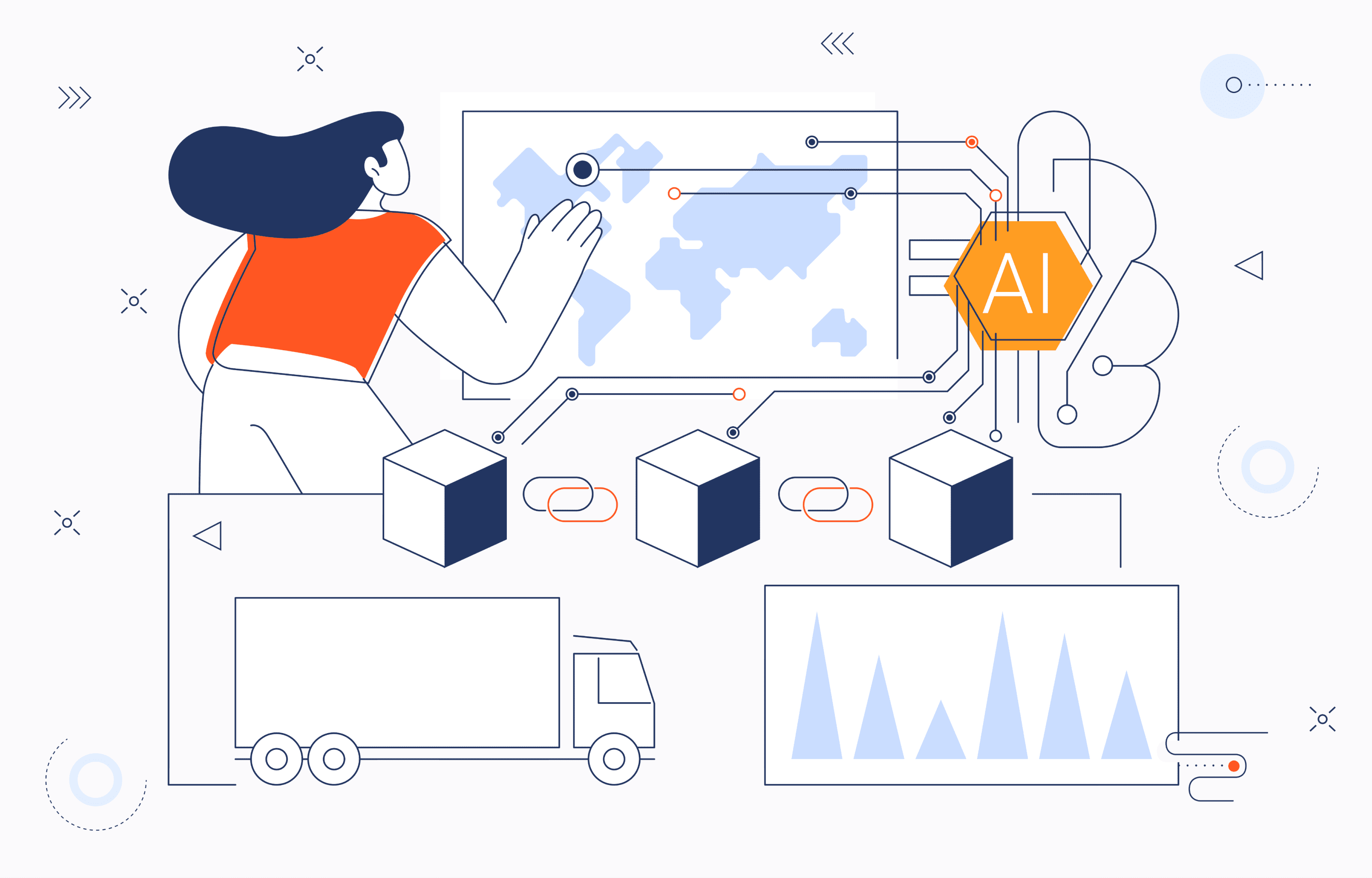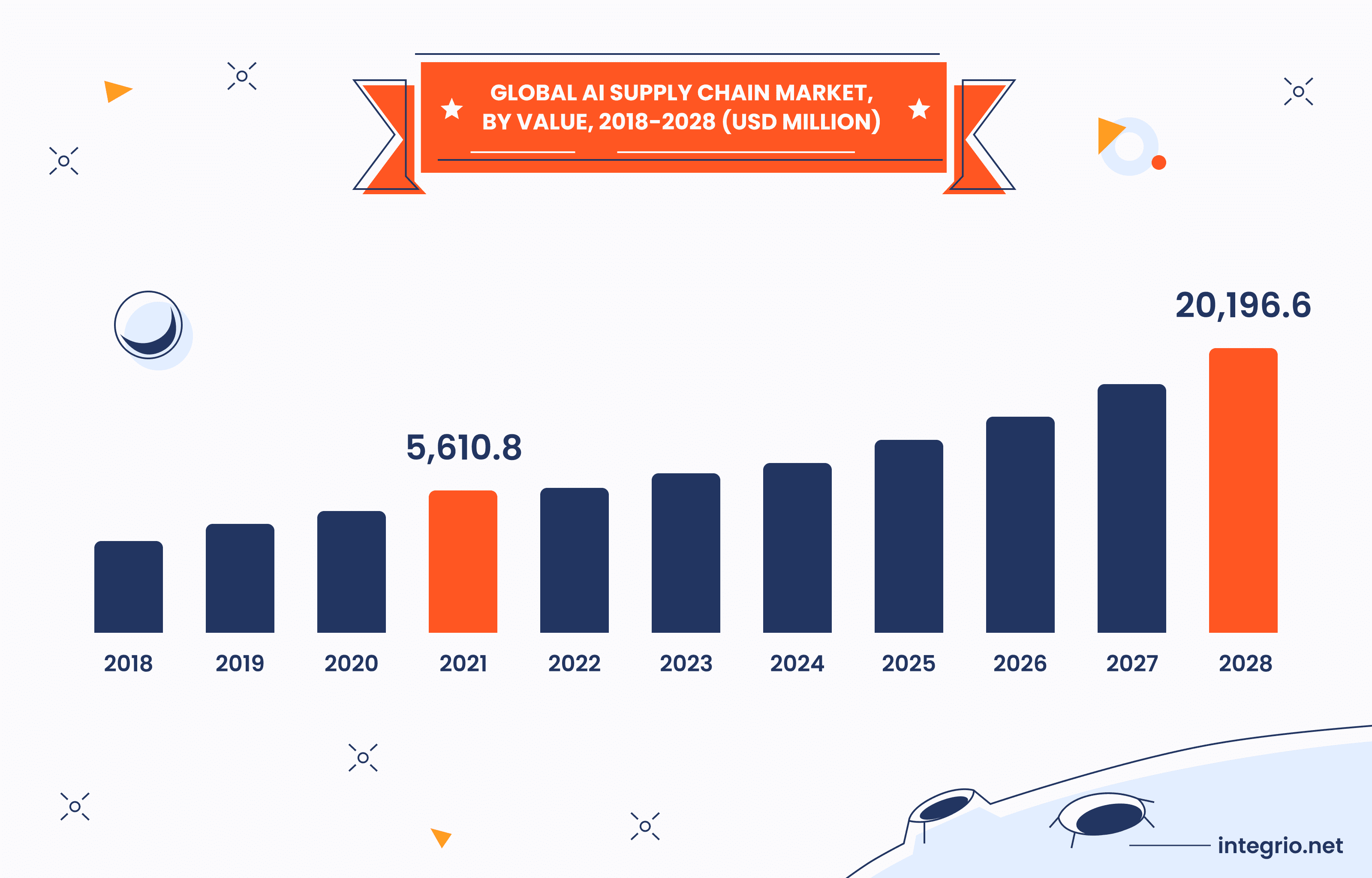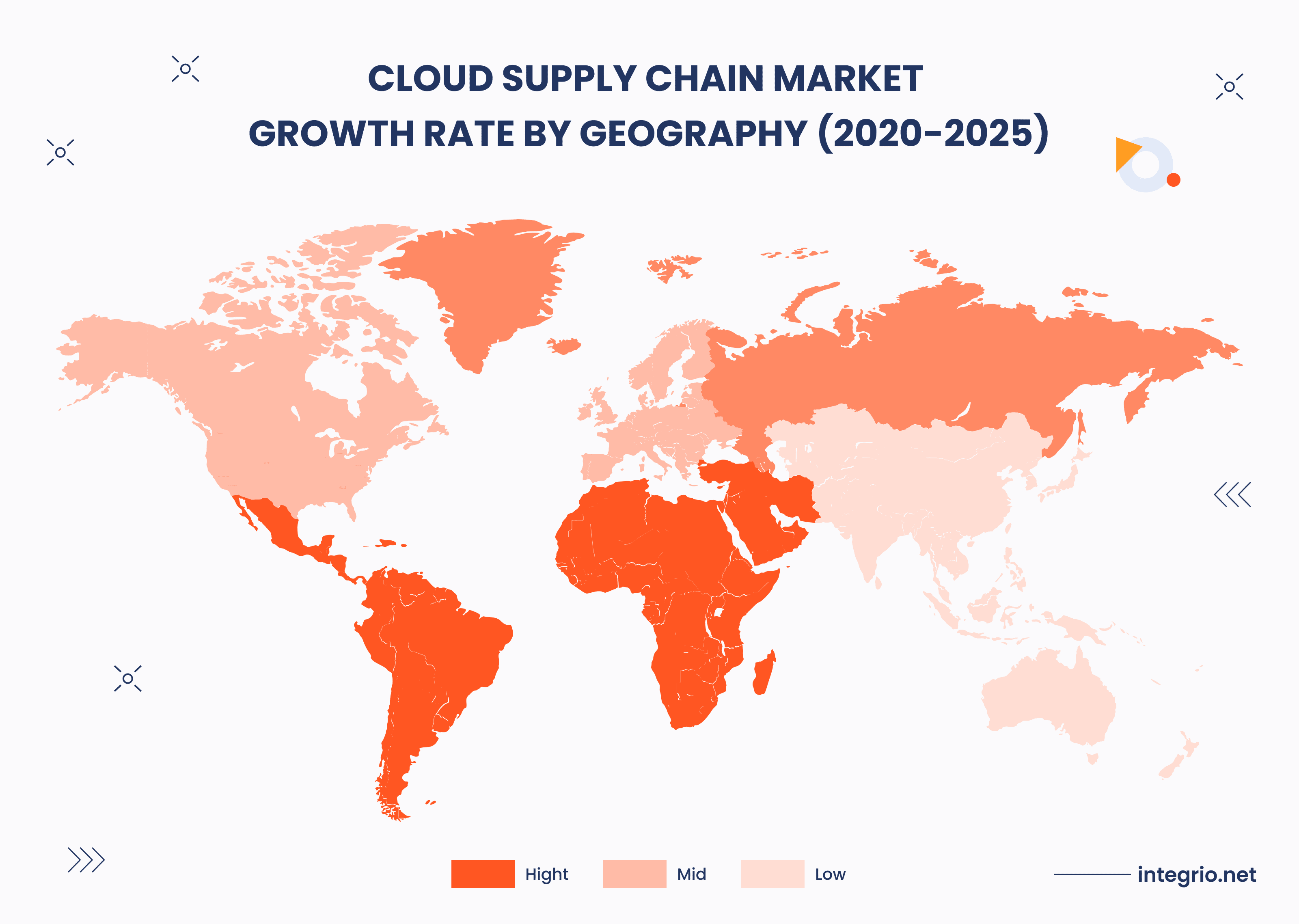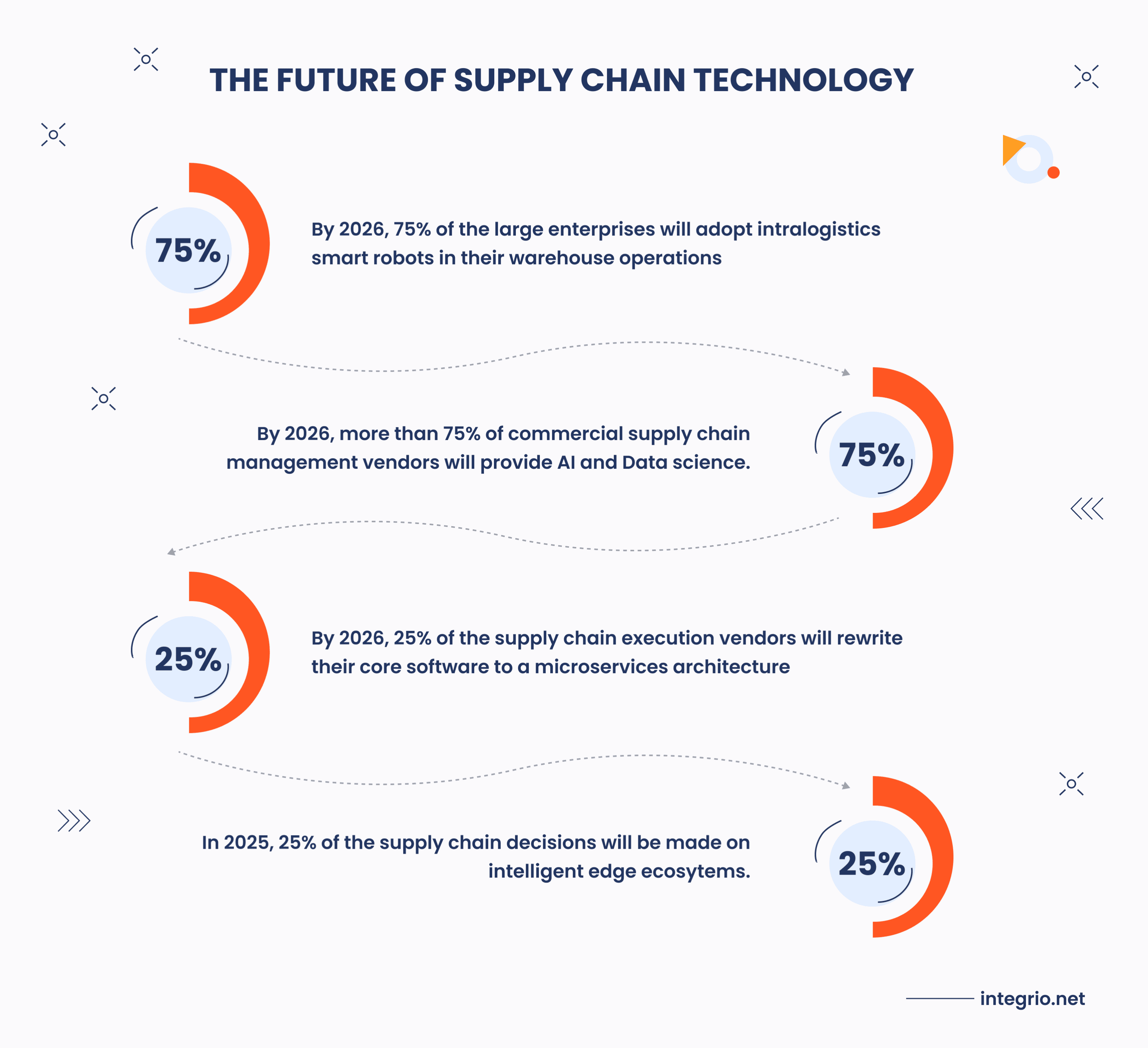5 Technologies Transforming Supply Chain in 2024

Participating in global supply chains helped Canadian businesses increase productivity (by 10%) and wages (by 6%). At the same time, research shows that it can leave organizations vulnerable to external supply and demand shocks. International dealings also leave businesses open to additional governance concerns. Yet, even smaller Canadian manufacturers and wholesalers join the global supply chains to reap the benefits.
Today, we will talk about the technology in supply chain management, its potential applications, and its impact on business. We’ll cover five major technological trends of 2024, spanning from artificial intelligence to robotization.
How Technologies Are Shaping the Supply Chain
Despite ongoing globalization, recent shocks to the global economy, including local armed conflicts and the pandemic, highlighted existing shortcomings. As a result, over half of U.S.-based senior decision-makers in logistics and supply chain strategy believe their supply chains require improvements. Despite continued alignment with the tech industry, most organizations consider existing solutions underperforming.
Digitization can make businesses more resilient to future supply chain disruptions. Adopting advanced technological solutions can help them achieve greater traceability and transparency, reduce the number of errors, boost efficiency, and proactively address supply chain problems. Let’s review 2024 tech trends shaping current manufacturing and logistics landscapes.
01.AI and Machine Learning
Machine learning (ML) and artificial intelligence (AI) will become critical for 38% of supply chain and manufacturing businesses globally in 2025. Over two-thirds will adopt AI or ML solutions, compared to 45% in 2022.
Here are a few examples of what smart algorithms can achieve:
Analyze past inventory and sales data to predict future seasonal demand. With that data, businesses can optimize warehouse inventory and organization for higher profit and easier order handling. Customers can order necessary items without facing shortages, increasing their satisfaction and boosting the chances of repurchase.
Automate routine tasks to free up employees and lower expenses. As AI takes over simple, repetitive tasks of creating shipping labels or estimating the best routes for pickers, businesses can reduce the workforce and refocus employees on other jobs. This will lead to higher accuracy and improved employee satisfaction.
Enhance decision-making for improved customer satisfaction and higher revenue. Depending on the data set, ML algorithms can predict the best vendors to use, optimize warehouse storage, etc. These insights help businesses make informed decisions that ultimately drive sales and improve the bottom line.
EAIGLE is one of the Scale AI projects designed to help supply chain and retail businesses. Their services include Automatic Vehicle Access Control (AVAC) for tracking trucks and trailers going through the gates, loading dock and truck parking monitoring solutions, and warehouse pallet tracking. The latter two optimize the loading and unloading process and reduce time wasted on locating misplaced pallets.
EAIGLE’s health and safety solutions cover early smoke detection and safety heat maps for identifying high-risk areas. Using existing hardware and infrastructure is among the major benefits, as it reduces the cost of adoption.

02.Cloud Computing
According to Gartner, global cloud service end-user spending nearly reached $600 billion in 2023, with a growth of almost 30% compared to 2022. Analysts expect the infrastructure-as-a-service (IaaS) market to keep growing. Moreover, businesses, including supply chain and logistics, will continue to optimize costs and minimize risks by adopting cloud-based solutions.
A few prominent benefits of cloud computing for supply chain management include:
Advanced visibility. Managers and employees can instantly access real-time data from all devices and locations. This clearly shows the current inventory, supply chain, bottlenecks, and trends. All of the above result in better (and faster) decision-making.
Enhanced collaboration. With access to the same data, stakeholders can combine their efforts and devise strategies to quickly address any issues. As long as you maintain control over access rights and security, cloud computing is an invaluable collaboration tool for any manufacturer or supply chain.
Efficient flexibility. Businesses can significantly reduce their hardware and maintenance spending by choosing cloud solutions. Moreover, they are easy to scale to fulfill real-time demands of the supply chain operation. Businesses can quickly scale cloud solutions up or down, accounting for seasonal demand or business model pivots.
Canadian-based Kinaxis integrated Google’s cloud solution into their supply chain management SaaS suite. The company helps businesses streamline their end-to-end supply chain networks, and integrating a cloud-based solution accelerated the onboarding and rollout process to under six months. Cloud processing made Kinaxis supply chain solutions scalable to suit businesses of all sizes.

03.Autonomous Vehicles and Drones
According to Carnegie Mellon researchers, small quadcopter drones offer up to 90% energy savings on last-mile delivery for small packages. As a result, delivery drones lower shipment costs, reduce workforce requirements, and ensure compliance with local ESG (environmental, social, and governance) requirements.
Aside from energy and fuel savings, autonomous and semi-autonomous vehicles improve safety, increase efficiency, and solve driver shortage problems. Although fully autonomous vehicles remain relatively rare, researchers expect to see 6.9 million self-driving units by 2030.
At the same time, according to DHL Canada, drones are a trending technology affecting supply chain management. They can have a moderate impact on supply chains. However, the company predicts the technology will take off only in five to ten years.
Yet, some solutions are already in place. For instance, Drone Delivery Canada integrated cargo drones into the Edmonton International Airport’s controlled airspace. Introducing cargo drones into the airport’s delivery ecosystem ensured fast, on-demand shipment of priority cargo, which is usually low-weight but high-value. Moreover, drones helped meet the ESG requirements by reducing CO2 emissions compared to traditional ground-level delivery vehicles.
04.Cybersecurity Solutions
Supply chain security breaches stemming from phishing, brute force attacks, or malware may disrupt operations for weeks and destroy business reputation, reducing revenue and leading to significant long-term losses. Moreover, ensuring the privacy and security of sensitive vendor and customer data falls under Canadian regulations, including PIPEDA and CASL.
According to the Canadian Center for Cyber Security, common supply chain compromises include:
Open-source software compromises can result in security breaches due to components present in supply chain solutions. In 2020 alone, GitHub located 26 repositories hosting Octopus Scanner malware.
Undermining code signing maintains the code signature while compromising the executable code, making it dangerous for end users’ devices. For example, Operation ShadowHammer used ASUS Live Update Utility to install malware across 500,000 computers in 2019.
Hijacked updates deliver compromised or malicious code that is to be distributed through trusted update channels. In an infamous case of this type of security breach, CCleaner updates were maliciously altered in 2017. By the time the attackers were disabled, over 2.2 million users had downloaded compromised updates.
Hardware contamination occurs when threat actors infect hardware to create a backdoor that can be later exploited. Although this approach is relatively uncommon, Schneider Electric shipped a batch of USB devices infected with malware in 2018.
In the wake of the SolarWinds breach of 2020, which disclosed sensitive information of US federal government agencies, the Canadian government convened a Supply Chain Assurance Working Group (SCAWG) to provide actionable cybersecurity recommendations for critical infrastructure companies. The recommendations range from adopting zero-trust architectures to switching to a principle-based cybersecurity assurance model in place of current standards and tooling.
According to Blackberry research, data encryption (63%) and identity access management controls (56%) are the most popular measures supply chain companies have in place.
05.Robotics and Automation
Automation and robotics offer endless improvement capabilities for supply chain management. Automated solutions can facilitate and speed up warehouse picking and packing to ensure accurate order fulfillment. RFID tagging coupled with robotic scanners can simplify inventory management. Besides, autonomous vehicles and drones can also be integrated into supply chain automation solutions, as we’ve already discussed.
Reducing human error is among the biggest benefits of supply chain automation. Robots can complete the picking, packing, and shipping tasks faster, with little idle time and increased productivity without the risk of introducing errors. Increased warehouse safety is another major advantage. Although the initial investment is a significant barrier preventing mass robotics adoption, it can reduce ongoing expenses by lowering workforce expenses. Still, increased customer satisfaction and the resultant rise in sales should contribute to robotization ROI.
Walmart Canada’s Regional Distribution Centre (RDC) in Calgary, Alberta, was the first to receive a high-tech robotics upgrade. Autonomous mobile robots (AMRs) transport pallets to processing stations, where depalletizers move them to conveyors. From there, automatic label applicators apply shipping labels. The integrated solution speeds up the shipment transition from trailers to storage by 90%. The facility also enjoys increased shipping accuracy and improved data analytics.
What Is the Future of Supply Chain Technology?

The five technological trends we covered will remain relevant for the foreseeable future. According to Gartner, investing in supply chain technology is an efficient way to future-proof your business.:
54% of customers will only choose sustainable companies. With Gen Z joining the customer pool, their number will likely increase. Drones and automated vehicles can help your company reduce its carbon footprint and align daily operations with your ESG goals. You can attract new customers by citing sustainability efforts in your mission statement.
43% of enterprises will digitize their operations and systems. Supply chains will need to adapt to the changing technological landscape. Investing in AI and ML-powered solutions and cloud-based storage and processing can help businesses accelerate their decision-making to address the new challenges. Increased agility will also help your business overcome unexpected supply chain disruptions caused by natural disasters or geopolitical instability.
Customers are 100% more likely to repurchase if supply chains enable them. Most of the technologies we’ve covered in this post can improve customer experience. AI-enabled stock decisions will ensure buyers have access to the products they need. Warehouse automation and robotization mean faster and more accurate shipping. Cybersecurity translates into solid reputation and low-risk purchases. Implementing these solutions may significantly impact your revenue streams.
54% of supply chains cite labor shortages as a business obstacle. Unfavorable working conditions drive one in five supply chain employees to seek new employment, further disrupting operations. Yet, implementing automation, robotization, and autonomous vehicles could improve their working environment, alleviate job strain, and make warehouses and distribution centers safer.
Incorporating disruptive technologies, such as cloud computing, AI, or cargo drone delivery, can generate value for logistics and supply chain organizations and help them achieve strategic goals.
Conclusion
Globalization makes supply chain management more important than ever for organizations, nations, and the world. Supply chains continue to evolve by adopting advanced technologies to address risks that arise. Adopting AI, cloud computing, robotics, and autonomous vehicles will remain an effective way to boost revenue for Canadian businesses for years to come.
Integrio has ample experience implementing sustainable software solutions in the manufacturing and supply chain sectors. We successfully integrate cybersecurity best practices, cloud computing, and smart algorithms into solutions for Canadian businesses, accounting for local regulations and federal government recommendations. So, if you need technology help in supply chain management, contact our team for a consultation.
Contact us

